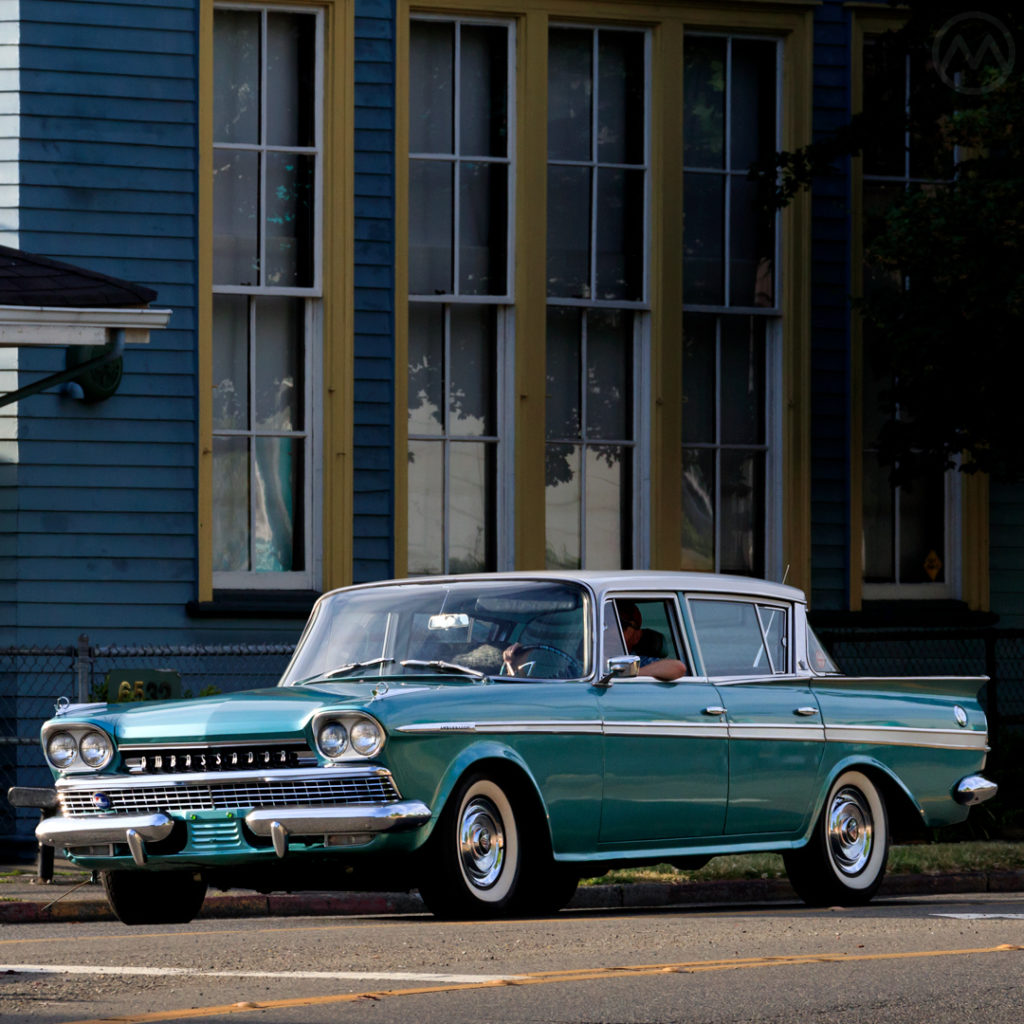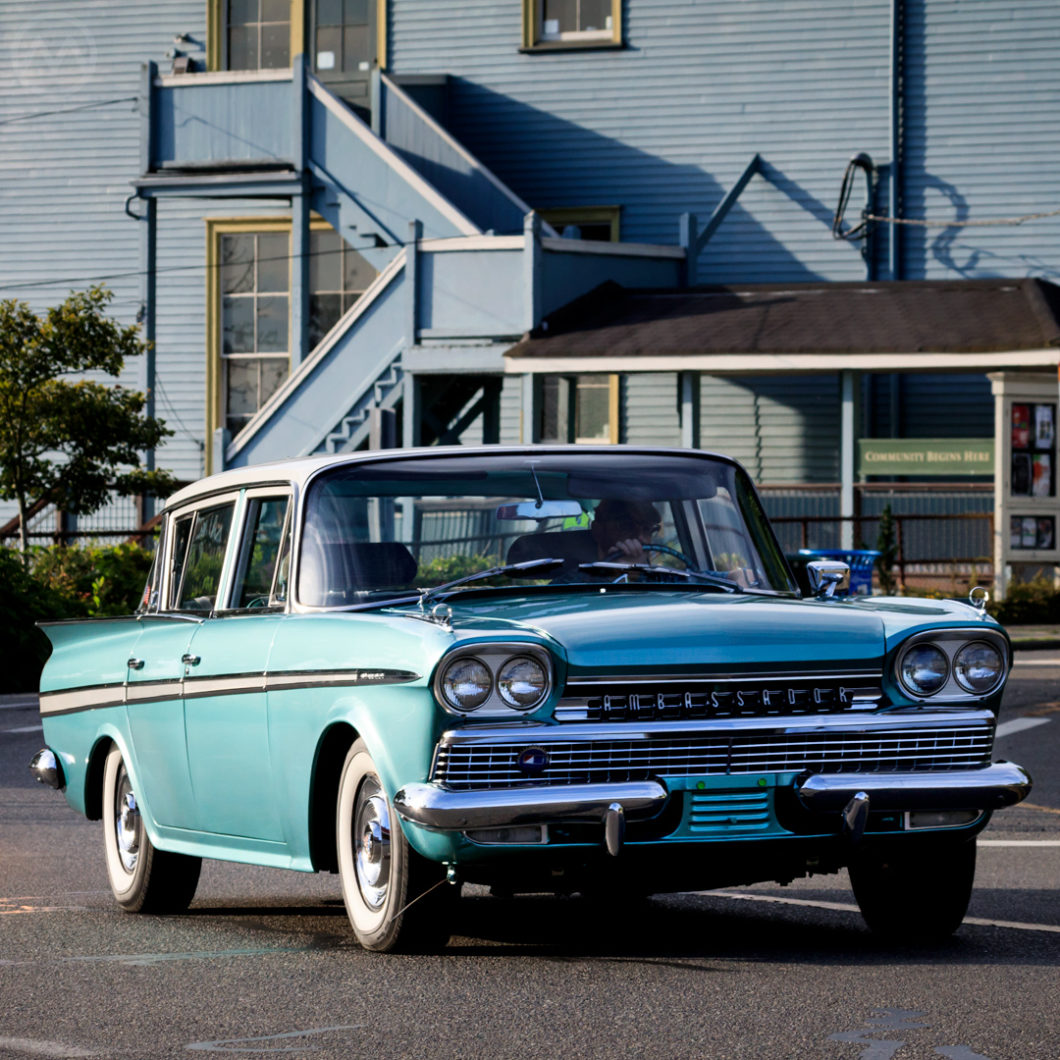American Motors was born on May 1, 1954, with the merger of Nash-Kelvinator and the Hudson Motor Car Co. By 1960 it was a very different company than Nash or Hudson had been, defined by its new name – Rambler, synonymous with small cars. But it still had a large car in the line, with an old Nash name, Ambassador.
The architect of the Nash-Hudson union (who originally saw it including Studebaker and Packard), the affable and smart George Mason, didn’t live to see the resolution of his plans. He passed away that October, leaving his protégé George Romney in charge.
Romney may have been Mason’s right hand, but he was an industry veteran. Mason had recruited him in 1948 after he’d been a higher up at the Automobile Manufacturer’s Association (AMA) for eight years. Before that, he’d been an executive at ALCOA.
Romney’s ambitious nature and personal bad chemistry with the equally domineering Jim Nance of Packard meant AMC never did tie-up with Studebaker-Packard. In hindsight that may have have been for the best; but Romney still inherited a newly-merged company in a deep crisis.
1955’s “Hashes”
Sales of the full-size Nash and Hudson models were way down, hurt by competition (in particular the Chevy-Ford sales war of 1953-4) and by their increasing age. Nash’s cars were newer than Hudson’s legendarily good “step-down” models, but both basic cars had been around awhile and neither company had the resources to properly replace them.
Hudson was in more dire straits than Nash, and the decisions about to what to do with the two lineups was, by necessity, tilted towards Nash and Mason’s, then Romney’s, management. For 1955, both makes would share an updated version of the increasingly dated 1952 Nash body.
Meanwhile, Nash’s original Rambler was the only one of the early 50s domestic “compacts” to do well, but a four-door Rambler (key to expanding the car’s appeal to mass-market consumers who might otherwise buy a Ford or Chevy) had only belatedly arrived in 1954.
For 1955, Hudson got badge-engineered Ramblers too – there was no money to truly differentiate them. Although cleverly styled to try and minimize the resemblance, the public greeted both full-size lineups skeptically as “Hashes,” with the relationship of the two badges of Rambler being obvious.
Big Hudson and Nash sales sank like a stone.
Two new cars were on the drawing boards of chief stylist Ed Anderson in 1954 – both slated for 1957. These were a set of new full-size ‘57s, and set of new ’57 Rambler four-doors and wagons. There was only money to build one and Romney chose to go all-in on Rambler.
Romney had believed in the Rambler because he’d seen compact projects during his time with the AMA. He’d come to Nash in part because he saw consumer demand for a smaller, more sensible car and Mason’s teams were working on one.
Despite the falterings of the Henry J, Willys Aero, and Hudson’s own Jet, there was clearly a market for “the right” compact car. With the other early 50s compacts all gone by ’55, the Rambler had a market to itself.
The new Ramblers were fast tracked and bowed for 1956, quickly eclipsing the fading Nashes and Hudsons, which would be dropped at the end of 1957. Romney was right. There was no denying that the Ramblers resonated with customers far more than the old big cars, but he hedged his bet in one respect.
One More Ambassador
But even after the decision was made to focus on the Rambler, there were voices inside the company who did not want to abandon the large cars. Work proceeded quickly on the Rambler but at the same time a plan was hatched to replace the big Hudsons and Nashes with an enlarged Rambler.
“If the small car gambit went bad, we had the Ambassador and could expand on it,” said exec Roy Chapin, Jr., executive vice president of the company when the new cars were introduced.
The new 4-door and wagon shell would get a larger version stretched ahead of the A-pillar for 1958. There were plans to have two distinct versions for Hudson and Nash and in fact renderings of such cars were actually published in contemporary magazines. However, in November, 1956, the board and Romney decided to terminate the two brands in favor of Rambler at the end of 1957.
Nash and Hudson production came to an abrupt end on June 25, 1957.
The decision to kill off the Hudson and Nash names in favor of Rambler came so late that early literature for the 1958 Ambassador had the names airbrushed out. Instead of two rebadged cars, the Ambassador would be just one – the Rambler Ambassador. It was introduced on October 27 that same year.
Extra Rambler
The “Big” Ambassador did not really look all that big – it was tall and narrow because of the proportions of the base design. It looked alright and continued the basic Nash themes, but was definitely boxy at a time when Chrysler had just reset how long and sleek a car could be. 1957’s iteration of the “Forward Look” set full-size car proportions for two decades.
It was nine inches longer than the the Rambler Rebel/Six/V8; almost all of which was extra wheelbase. Sharing bodies, it came as a four-door sedan or a wagon. The former Nash “Fashion Safety Arch” reverse-slanted C-pillar again appeared on all cars derived from this chassis.
Incorporating this feature allowed continuity and made it cheaper to tool up for wagons, but it was already a dated styling trademark even in 1958.
The new Ambassador was smaller than the ‘57 Nash but only by a few inches, and came only with AMC’s 327 V8. This engine was designed by ex-Kaiser-Frazer and Continental engineer Dave Potter as part of an extensive program to develop AMC’s own engines and put Studebaker-Packard out of the picture altogether – Nash had previously been supplied with Packard V8s and Ultramatics.

250 lbs. lighter than the old Nash, it was also appreciably faster – but few were hooked. Only one Ambassador sold for every ten regular Ramblers in ‘58. About 7,000 were made (not the 1,200 or so sometimes cited). Nevertheless, 1958 was a very good year for Rambler – a return to profit and big sales, while other makes struggled in the Eisenhower Recession, which surely would have finished off Hudson or Nash.
Ambassador sales rose to 23K units in ‘59 and about the same for 1960.
All Ramblers except for the lowest-model Rambler American were restyled for 1960 with a crisp new look courtesy of Ed Anderson and William Reddig. The detail work on the design was much more delicate and ornate than the broad, slab-sided expanses of the 1958/59 Ambassadors, and the cars really looked new – although the reverse-rake C-pillar stood out as something the company couldn’t easily change.
An unfortunate second restyle awaited in ‘61 with an unhappy shovel-nosed look, making the 1960 and 1961 models unique in their own ways, but the ’60 was a more cohesive design. That same year the Rambler Six/V8/Rebel were consolidated into the “Rambler Classic.”
The Ambassador also had a range within its lineup from truly slow-selling low spec cars (Deluxe sedan, 155 sold in 1960) to volume middle-class cars (Custom, 10,791 sedans sold in 1960).
Romney was definitely vindicated in 1958-60, when demand for compacts and small cars soared and AMC was well positioned to deliver. The freshly restyled Six, V8, and Rebel coupled with the revived Rambler American buoyed AMC to third place in the industry.
This was a title no independent manufacturer had achieved since 1929. Ironically the last car to do that was a distant relative – the 1929 Essex, part of the once larger Hudson-Essex-Terraplane lineup. But the Ambassador, while not a bad car, wasn’t where the action was.
Good to drive and well-equipped, it was nevertheless an also-ran, and lost its long wheelbase to become a fancy trim version of the Classic for 1962. It was worthy but nobody mistook it for a Cadillac.
The Ambassador name continued into 1974, though the car didn’t actually reach nearly full-size dimensions again until 1967 – a story for another day.


My first car bought it in 1967 didn’t even have a license to drive yet. Payed $75.00 for it and $68.00 to register and get NJ state insurance. drove it all over Jersey City. loaded it up New Years Eve1968 with 8 buddies and headed up to Journal Square White Castle and ordered 118 burgers. They didn’t even flinch ” coming right up ” they said it cost us $15.00. most fun we ever had we were all under 18 years old. a year latter i junk it engine went . Bought a 64 chevy impala convertible had fun with that also